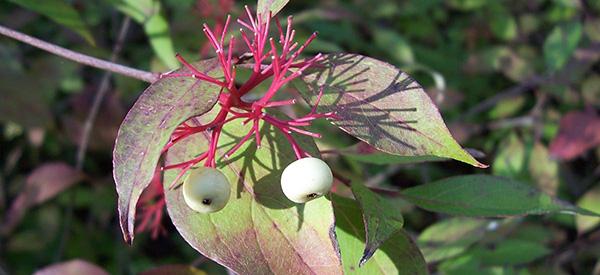
Red Osier Dogwood
Red osier dogwood (Cornus sericea) was formerly known as Cornus stolonifera and Swida sericea. A North American native flowering plant in the Cornaceae family, red osier dogwood is also known as red willow, redstem dogwood, western dogwood, red twig dogwood, creek dogwood, and red brush.
The genus Cornus holds 30 to 60 species. Cornus is Latin for horn, indicating the hardness of the wood. Dogwoods are important ornamental garden plants with some species being small herbaceous perennials while others are long-lived flowering trees. Sericea in Latin means silky which refers to the silky texture of red osier dogwood leaves. The name red osier means red willowy shoot in French. This is due to red osier dogwoods resembling leafless willows in winter.
Red Osier Dogwood Uses
Red osier dogwoods are deciduous shrubs that are exceptionally attractive in the landscape. The bright red stems are particularly stunning in winter. This wetland plant provides soil retention and erosion control. Tolerant of moisture and flooding, red osier dogwoods are often used in naturalizing and restoration projects.
An important wildlife plant, many animals use red osier for food and shelter. The branches make excellent browse for deer, elk, moose, beaver, and rabbit. The fragrant blooms in May and June attract many beneficial pollinators. It is a butterfly larval host plant for many species including Spring Azure butterflies. Many bird species use red osier dogwood for either nesting or as a food source, eating the bluish-white berries of early fall.
The History of Red Osier Dogwood

As a useful North American native shrub, red osier dogwood holds an important place in the natural history of the continent. As a food source, red osier dogwood is browsed by many ungulates including elk, bighorn sheep, mountain goats, and moose. The twigs are used by beavers, rabbits, and other small mammals as food and shelter. Red osier branches provide shelter and nesting habitat to many small animals as well as many bird species. The shrub is a butterfly and moth, larval host. The edible berries in fall are an important food source for many animals and about 47 species of birds including waterfowl, shorebirds, grouse, and quail.
Indigenous people of North America have also historically used red osier dogwood. Branches were used in basket weaving and wicker making. The branches gathered in spring hold their bright red color well. The durable, straight hardwood of red osier dogwood was used to make tools such as bows, arrow shafts, stakes, and skewers. The aromatic wood added a nice flavor to skewered foods. Very strong and long-lasting, the opposite branching creates perfect Y-shaped forks for slingshots, as well as cooking racks, hangers, and cooking frames. Some indigenous tribes ate the berries or mixed the berries with other foods. The colorful bark was used as an ingredient in dye-making. The bark, leaves, and roots were used to make medicines. The inner bark was shaved and dried to use in ceremonial smoking mixtures by some indigenous people.
Where Red Osier Dogwood is Found
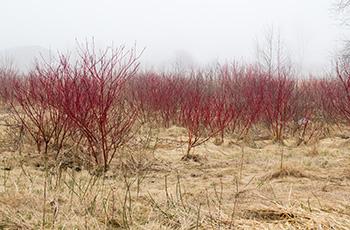 Red osier dogwood is widespread throughout northern and western North America. It is native to boreal and temperate areas in riparian and wetland regions. Preferring to grow in rich, poorly drained soils, red osier dogwood can tolerate flooding even over several years. Common along stream banks, river edges, floodplains, marshes, and meadows. In areas of high precipitation, 20 inches or more annually, red osier dogwood can be found from sea level to 10,000 feet, but most commonly at elevations above 1500 feet. It stands out in the landscape with bright red stems in winter which are gorgeous against paper birch and aspen which may be found growing nearby.
Red osier dogwood is widespread throughout northern and western North America. It is native to boreal and temperate areas in riparian and wetland regions. Preferring to grow in rich, poorly drained soils, red osier dogwood can tolerate flooding even over several years. Common along stream banks, river edges, floodplains, marshes, and meadows. In areas of high precipitation, 20 inches or more annually, red osier dogwood can be found from sea level to 10,000 feet, but most commonly at elevations above 1500 feet. It stands out in the landscape with bright red stems in winter which are gorgeous against paper birch and aspen which may be found growing nearby.
Related: The Complete Map of Edible Plants: Find Out What You Have in Your Area!(Video)
How to Identify Name
- Shape: Upright, multi-stemmed, opposite branching, loose, spreading, deciduous shrub 6 to 12 feet tall and wide.
 Leaves: Opposite leaves are oval with pointed tips, 2 ½ to 5 inches long, glossy green on top surface with paler undersides. Deep maroon to burgundy in fall.
Leaves: Opposite leaves are oval with pointed tips, 2 ½ to 5 inches long, glossy green on top surface with paler undersides. Deep maroon to burgundy in fall.- Flower: Clusters of cream-white, tiny flowers
 form 2-to-3-inch flat umbels at stem tips which bloom in early spring in May to June.
form 2-to-3-inch flat umbels at stem tips which bloom in early spring in May to June. - Stem: Bright red twigs when young, with color darkening with maturity.
- Fruit & Seeds: Clusters of ¼ inch, blue-white berries are smooth to slightly hairy with each containing a single hard flattened edible seed.
Related: Plant Identification Guide – 400 Wild Plants That You Can Forage For (Video)
How to Grow Red Osier Dogwood
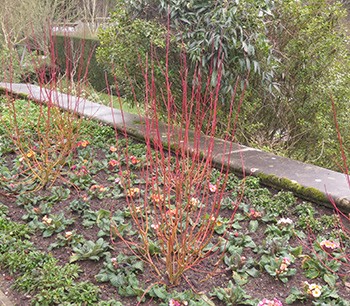
An extremely moisture tolerant and cold hardy shrub, red osier dogwoods are hardy in zones 2 to 9. They prefer part shade, although stem color may be brighter in sunnier locations. Soil can be well-draining to poorly draining with an acidic, neutral, or alkaline pH. Although very adaptable to soil and climate, red osier dogwoods are not very drought tolerant. They are susceptible to blight and scale problems.
Red osier dogwood can be propagated by seed or cuttings. Hardwood cuttings collected in late winter may sprout without treatment and sprouts are easy to establish. Seeds can be sown or stored with or without removing them from the fruit. A period of stratification for 60 to 90 days at 40° is needed for germination.
Related: 10 Plants That You Should Never Plant Together (Video)
How to Harvest Red Osier Dogwood
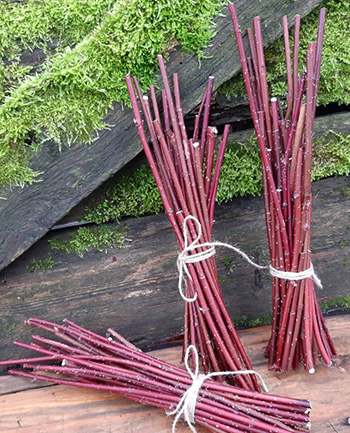
Prune young branches from this season’s growth in fall. Choose branches that are less than a pencil width across. A little goes a long way with red osier dogwood bark so gather just what you need.
With sharp pruning shears or scissors, cut branches that are 6 to 10 inches long.
At this time of year, autumn, the branches will be tending towards dormancy. They can be stored in a cool dry place until ready for use.
Expose the bark’s inner cambium layer of the harvested branches by peeling the bark. A sharp knife or potato peeler are good tools for this task.
Related: Plants and Fruits That You Would Better Forage In Winter (Video)
What Red Osier Dogwood Is Good For & The Natural Remedies Made From It
Red osier dogwood is a common shrub of the ornamental plant trade due to its striking form, ease of growth, and vibrant winter color. Excitingly, this abundant North American native plant also provides many healthful benefits. Notably, the bark and root bark possess analgesic, astringent, and stimulating compounds.
Remedies made from red osier dogwood can be taken internally or externally. Internally, red osier dogwood tea or tincture may aid coughs, colds, headaches, and fevers. Externally, an infusion or decoction can be used to help treat skin ailments, rashes, infections, wounds, and sores. A decoction or infusion of the bark applied topically helps to relieve sore, tight, and overworked muscles. A poultice made of soaked inner bark may help treat painful conditions and stop bleeding.
What Parts of Red Osier Dogwood Are Used in Remedies?
The bark and root bark of red osier dogwood contain many health-promoting bioactive compounds. These include quercetin, gallic acid, ellagic acid, oligomeric proanthocyanidins, tyrosol, and rutin. Combined, red osier dogwood is a precious plant resource rich in antioxidative activity.
- Quercetin is a flavonoid compound found in plant pigments. It is known to have anti-inflammatory and antioxidant effects. These reduce swelling and pain and help to protect tissue from damage.
- Gallic acid is a compound that has beneficial antioxidant, anti-inflammatory, and antineoplastic activity.
- Ellagic acid is also a powerful natural antioxidant that contributes to anti-inflammatory and cancer-fighting compounds found in red osier dogwood.
- Oligomeric proanthocyanidins are polyphenols that act as protective antioxidants and provide the deep rich red, blue, and purple color to many plants.
- Tyrosol, one of the active healthful ingredients of olive oil, is known to have many benefits including providing powerful antioxidant protection.
- Rutin is a bioflavonoid with many health-promoting effects including analgesic, antioxidant, and neuroprotective benefits.
A DIY Recipe for Red Osier Dogwood Cold Water Infusion
This recipe can be made ahead of time. It is great for use at home. Due to the common and abundant nature of red osier dogwood, this cold infusion can also be made in the outdoors and on the go. It has multiple uses and benefits. Primarily, red osier dogwood cold water infusion helps to reduce pain and soreness from taxed and overworked muscles. It is also a safe and effective wound wash due to the antiseptic nature of red osier dogwood. As red osier dogwood is analgesic and astringent, this cold infusion is also helpful with skin ailments such as poison ivy rash.
Method
STEP 1: Identify red osier dogwood. You may know of red osier dogwood growing nearby or some that is planted in the landscape. It may blend in with a lot of other wild shrubs in spring and summer. The leaves in fall are a deep maroon which stands out. In winter, the bright red stems help to identify this plant.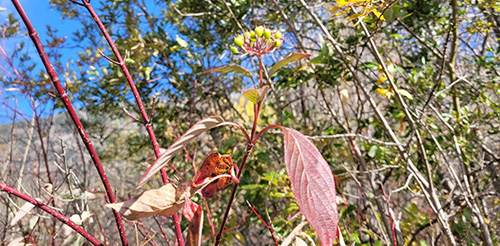
STEP 2: With sharp pruning shears or scissors, cut branches that are 6 to 10 inches long. Young branches from this season’s growth are best. Branches less than a pencil width across are usually large enough. A little goes a long way with red osier dogwood bark so gather just what you need. In autumn the branches will be going into dormancy. Store them in a cool dry place until ready for use.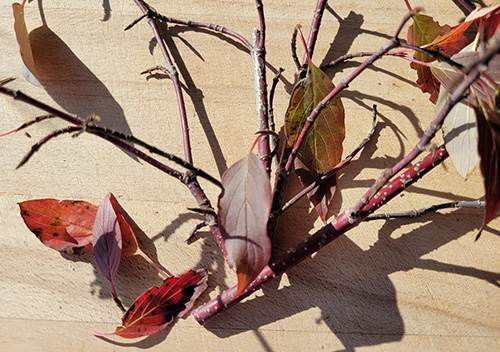
STEP 3: For the cold water infusion, expose the bark’s inner cambium layer. Take the harvested branches and peel the bark using a sharp knife or potato peeler.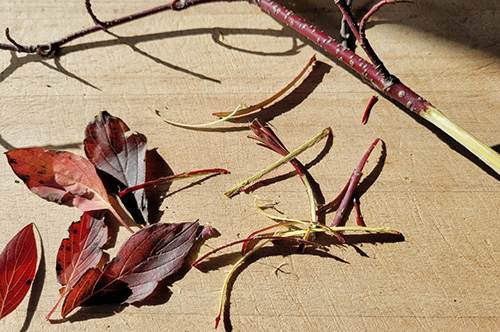
STEP 4: Gather the peeled bark and trimmings. The peeled twigs are also useful as the beneficial compounds are on both the peelings and the peeled twigs. The aroma of the red osier dogwood sap is clean, fresh, with a bright woodsy smell that is surprisingly very pleasant.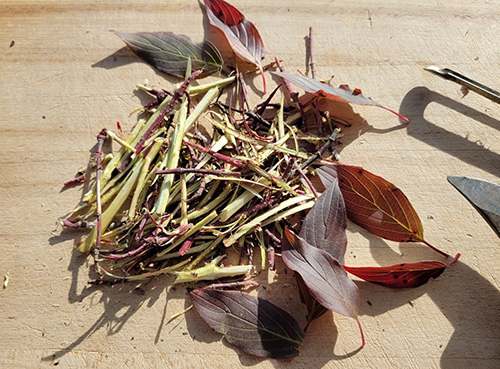
STEP 5: Place the twigs and peeled bark in a sterile jar. In the outdoors, as clean a container as you can find is best. This would be particularly important if the infusion is to be used in wound cleaning.
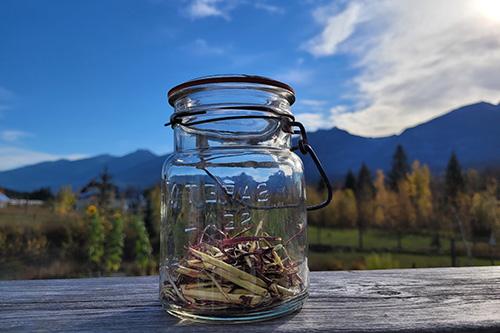
STEP 6: Cover the twigs with high-quality, fresh water. If possible, boil the water for sterility and purity. Hot or warm water can be used in the infusion as it may help extract the beneficial compounds from the fragrant wood.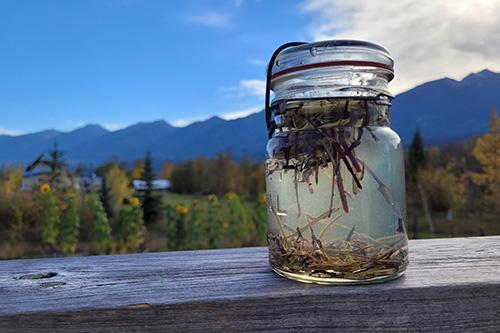
STEP 7: Allow the infusion to steep for 12 to 24 hours at room temperature. This infusion was made in the sunny window rather than in a dark place protected from light. It just became prettier and prettier as the red pigments bloomed in the water.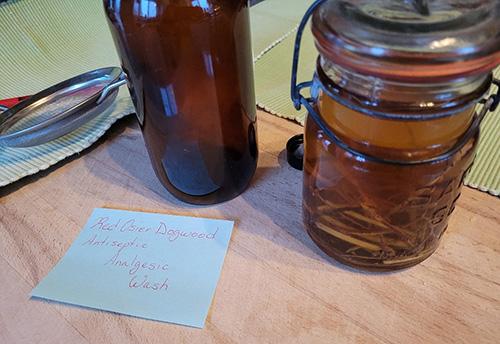
STEP 8: Filter the twigs and bark and place the cold-water infusion in a sterile glass jar. This antiseptic, analgesic wash can be used right away.
STEP 9: The bottle of red osier dogwood water infusion is ready to use. This water infusion or decoction may have a short shelf life of 24 to 48 hours. For me, the infusion lasts up to 3 weeks. This may be due to the antiseptic nature of the infusion, the very alkaline well water, low humidity, and high elevation where I live. To extend the shelf life for this topical analgesic wash try adding 1 ounce of rubbing alcohol per cup of red osier dogwood cold water infusion.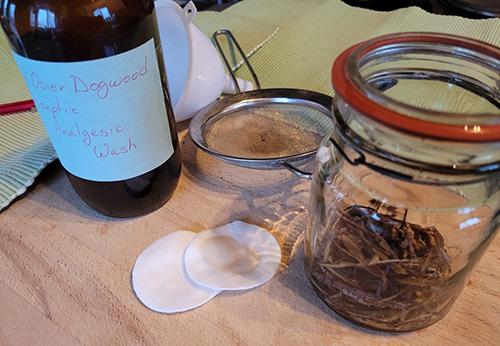
STEP 10: For a longer lasting red osier dogwood cold water infusion, the rosy liquid can be frozen into conveniently sized ice cubes. These ice cubes are perfect, especially if you don’t want to use an alcohol-based preservative on your skin.
Potential Uses
Is there anything more convenient than a pain reliever you can make on the go? In the event of a long stay in the woods, the abundant and easy to identify red osier dogwood can come to the rescue.
Red Osier Dogwood Cold Water Infusion Uses
- Sooth aching muscles by soaking the infusion into compress and place over affected areas.
- Use infusion to wash wounds to help stave off infection.
- Use a tablespoon or ice cube of infusion in a foot soak or bathwater to relieve sore muscles and joints.
- The infusion can also be put in a spray bottle and sprayed on the affected tight muscles or sore areas of skin.
Related: The Unnoticed Symptom That May Point to an Internal Inflammation (Video)
Dosage
There is a lack of research available to define a dose for red osier dogwood.
For topical therapeutic use, apply a tablespoon at a time until therapeutic relief is found.
For myself, for tight neck muscles, a cold compress of this red osier dogwood cold water infusion relieved tense neck muscles surprisingly well with just one application. The effect, impressively, lasted longer than 36 hours.
How To Preserve Red Osier Dogwood?
Collected red osier dogwood branches can be kept in a cool dry place until ready for use. Alternatively, the bark can be peeled off the stems and dried for future use. Fresh or dried bark can be made into a decoction, tea, or topical wash as in the recipe above. The bark can also be preserved by making a tincture or an oil infusion.
To dry red osier dogwood bark, chip the peeled bark into small pieces. Place in a single layer on a cookie sheet. Put sheet in a dark place with excellent air circulation. Stir bark chips once or twice a day until dry. The more resinous the bark, the longer the drying period. For red osier dogwood, it may take up to 1 to 2 weeks to dry fully. A humid environment or spring-harvested bark will need a longer drying period. Place dried bark in a sterile, airtight container. Dried red osier dogwood bark may keep for several years.
What Plants Resemble Red Osier Dogwood?
| Feature | Cornus sericea, Red Osier Dogwood | Sambucus nigra, Black Elderberry | Salix alba, White Willow |
|---|---|---|---|
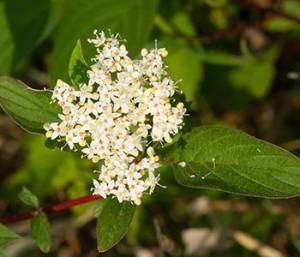 | 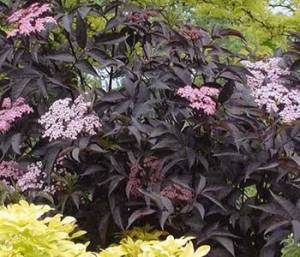 | 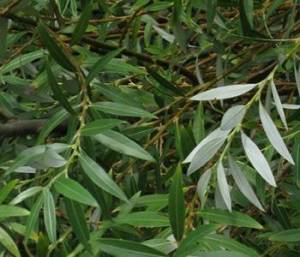 | |
| Size | Upright, multi-stemmed, opposite branching, loose, spreading, deciduous shrub 6 to 12 feet tall and wide. | Deciduous shrub or small tree reaching 20 feet tall and wide. | Medium to large deciduous tree growing 30 to 90 feet. |
| Leaves | Opposite leaves are oval with pointed tips, 2 ½ to 5 inches long, glossy green on top surface with paler undersides. Deep maroon to burgundy in fall. | 4- to 12-inch-long pinnate leaves with 5 to 7 opposite leaflets. | Narrow leaves are 2 ½ to 5 inches long, pale, with fine hairs. |
| Flowers | Clusters of cream-white, tiny flowers form 2-to-3-inch flat umbels at stem tips which bloom in early spring in May to June. | White clusters of 5-petaled flowers are 4 to 12 inches across. | Long catkins 1 to 2 inches long. |
| Bark | Bright red twigs when young, with color darkening with maturity. | Light gray when young becoming course and furrowed with maturity. | Gray with some cultivars bright red stems when young. |
Warnings And Cautions
Plant is considered safe for topical use. For skin sensitive people do a small skin test by placing a small amount of the infusion or bark resin on the skin and wait 24 hours. Any reaction such as itchiness or hives may be an indication of a sensitivity. It only makes sense to practice some caution with topical use for people who suffer from seasonal allergies.
Check with your healthcare provider before starting new herbal remedies.
You may also like:
 The Killer Tree You Should Never Have In Your Backyard
The Killer Tree You Should Never Have In Your Backyard
American Beech Nuts – A Staple At The Grocery Store 100 Years Ago (Video)
How To Make a Cinnamon Painkilling Tincture
10 Natural Remedies You Can Only Make This Winter
How to Identify the Ginkgo Biloba Tree: Does It Grow on Your Street?






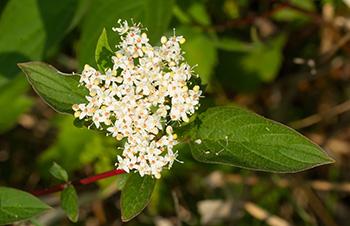
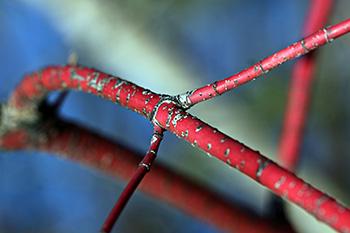 Leaves: Opposite leaves are oval with pointed tips, 2 ½ to 5 inches long, glossy green on top surface with paler undersides. Deep maroon to burgundy in fall.
Leaves: Opposite leaves are oval with pointed tips, 2 ½ to 5 inches long, glossy green on top surface with paler undersides. Deep maroon to burgundy in fall.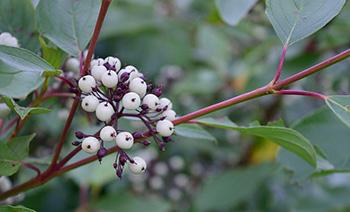 form 2-to-3-inch flat umbels at stem tips which bloom in early spring in May to June.
form 2-to-3-inch flat umbels at stem tips which bloom in early spring in May to June.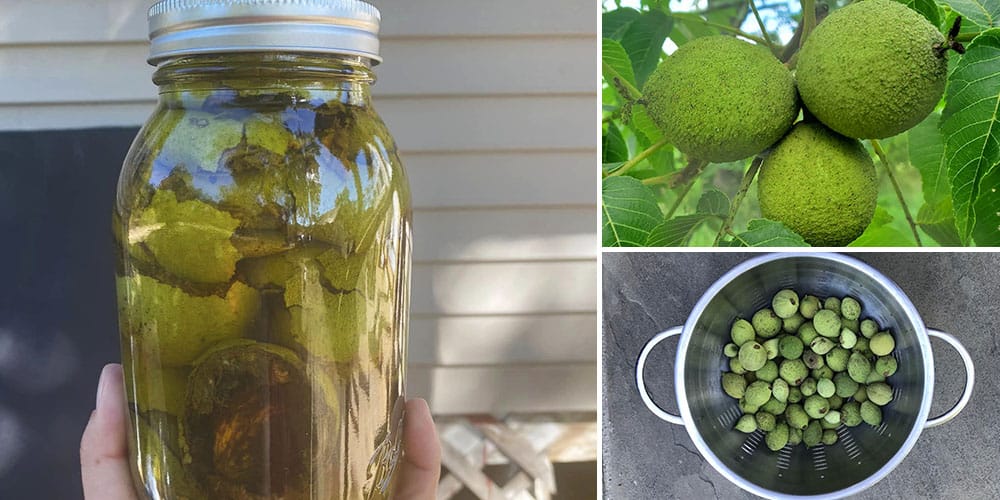
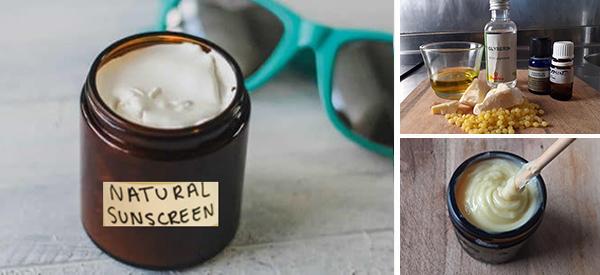
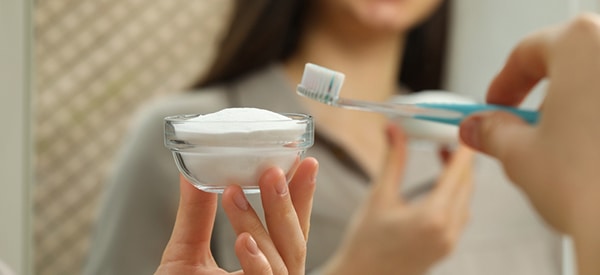
Good stuff thank you
Very interesting. Many thanks
Can’t wait to learn some of this!
Well covered, highly informative.